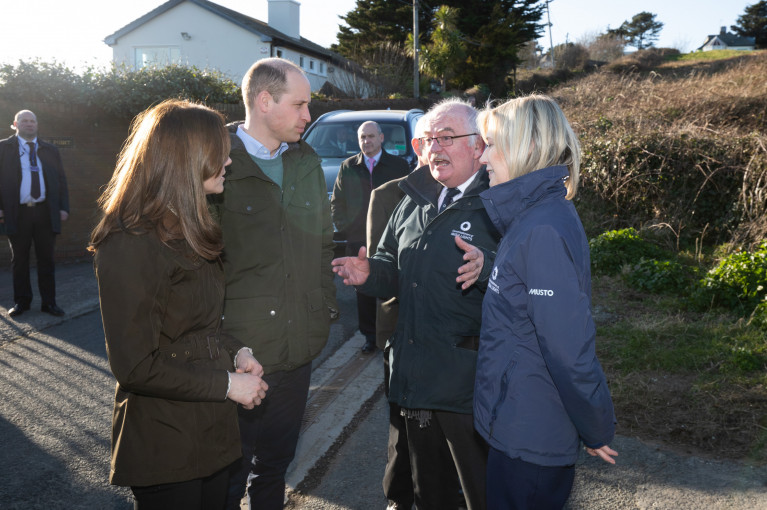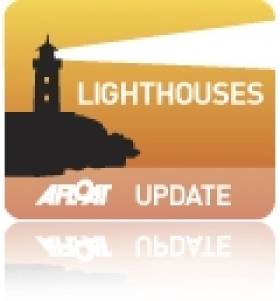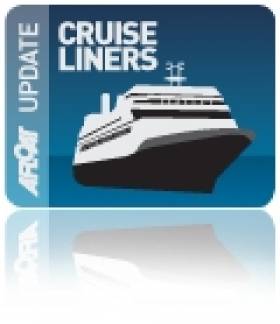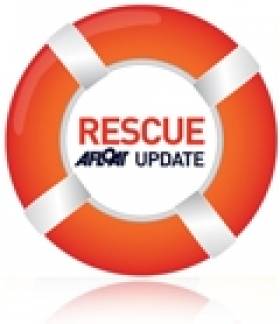Displaying items by tag: Baily Lighthouse
Irish Lights Also Welcomes Duke and Duchess of Cambridge to Howth at the Baily Lighthouse
The Commissioners of Irish Lights were also delighted to welcome The Duke and Duchess of Cambridge yesterday to the Baily Lighthouse, Howth Peninsula (see story: Marine Institute) as part of the UK Royal couple's first official visit to Ireland which concludes today.
According to CIL, the Duke and Duchess of Cambridge met with Kieran Crowley, Chairman and Yvonne Shields O’Connor, CEO, Irish Lights at the Baily Lighthouse (marking the northern approaches to Dublin Bay). They discussed the long-standing historic relationship between Irish Lights and their General Lighthouse Authority (GLA) partners in the United Kingdom, Trinity House and Northern Lighthouse Board.
This active partnership sees the three authorities co-operating on a daily basis to deliver a range of services to ensure safe navigation around the Irish and UK coasts, meeting the Irish and UK governments’ obligations under the Safety of Life at Sea Convention.
Yvonne Shields O’Connor, CEO, Irish Lights said: "It is an honour to welcome Their Royal Highnesses The Duke and Duchess of Cambridge and to acknowledge the close working partnership that exists between Irish Lights and our colleagues in Trinity House and the Northern Lighthouse Board. For over 150 years we have worked in close collaboration to ensure safety at sea for mariners through our network of lighthouses, buoys and electronic aids to navigation. We recognise the hugely valuable work Their Royal Highnesses are doing in relation to climate change and marine conservation, which is very relevant to the service that we provide.”
Afloat adds the visit follows less than a year ago when Princess Anne in April 2019 also visited the Baily Lighthouse in addition to CIL's headquarters in Dun Laoghaire Harbour and boarded the ILV Granuaile (named after the 16th century Irish Pirate Queen from Mayo). Grace O'Malley who was regarded as a rebel, pirate and had 'disloyal' activities sailed to London to meet Queen Elizabeth I at Greenwich Palace in 1593.
Role on to the present day as Princess Anne, The Princess Royal is Master of The Corporation of Trinity House, a position held since May 2011. It was in that same month and year when Queen Elizabeth II made a historic first visit to Ireland.
Trinity House as one of the trio of GLA partners is responsble for the waters off England, Wales, the Channel Islands and Gibraltar, while Northern Lighthouse Board has the seas off Scotland and the Isle of Man. As for the remaining partner, Irish Lights whose mission is the safe navigation at sea and as a maritime organisation delivering essential 24/7 safety and navigation services around the coast to include N. Ireland.
Software Firm Moves Into Baily Lighthouse
#LIGHTHOUSES - A software firm specialising in emergency response technology has made its new home at the Baily Lighthouse in Dublin Bay, according to The Irish Times.
The Howth Head lighthouse is the last in the State to become fully automated, and the vacancy in the adjacent offices is being filled by Decisions [D4H].
The software company was started by emergency responders who develop remote service technology for oil exploration, hazmat workers, firefighters, coastguards and more the world over.
[D4H]'s new location will house the company's engineers, customer service staff and management.
Ultra Deepwater Installation Vessel Calls to Dublin Port
#PORTS & SHIPPING – One of the world's largest and most advanced ultra deepwater installation and cable laying construction vessels, the AMC Connector arrived into Dublin Bay this morning, having picked-up a pilot offshore of the Baily Lighthouse, writes Jehan Ashmore.
The Norwegian flagged 19,000 tonnes vessel which was only launched last year is capable of operating in waters beyond 3,000m. She is fitted with Dynamic Positioning (DP3) technology, which allows the vessel to maintain a precise and constant position using satellite technology while operating in harsh weather conditions.
AMC Connector is able to install power cables and umbilicals using its two heave-compensated offshore cranes and a VLS system with pay-load capacity of 9,000 tonnes. There are two carousel turntables for the cables, one capable of handling 6,000mt above deck and the second of 3,000mt capacity is sited below deck. There are two remotely operated vehicles (ROV) and a single centred moonpool in addition to two sliding to the port side.
The 156m ship has accommodation for up to 140 personnel plus a hospital. In front of the bridge and directly above the bow is a heli-deck which is designed for Sikorsky S-92 type helicopters. This is the same type of helicopter that was recently introduced as the new SAR helicopter for the Irish Coast Guard (ICG).
The red-hulled vessel is part of a modern fleet operated by the EMAS AMC, which is an Olso based offshore contractor offering subsea construction, installation, maintenance, repair and decommissioning services. They specialise in complex projects in any environment throughout the world.
Giant New Car Truck Carrier Docks in Dublin
She is operated by Wallenius Wilhelmsen Lines (WWL) and was built by Daewoo Shipbuilding & Marine Engineering. The new vessel's principle dimensions are (length: 227.8m, beam: 32.26 and a draft of 11.3m) and she has a deadweight (metric tonnes) of 30,900.
The Swedish company together with subsidiaries and partner's, operates a fleet of about 135 vessels. Of these, Wallenius owns or charters around 35. They can carry up to 8,000 cars, or a combination of cars, trucks, cranes, large rolls of paper and rubber or large turbines. They have also transported parts for wind turbines, luxury yachts, complete train-sets and aircraft wings.
Figaro's docking in Dublin today was at berth 33, which is the centre berth of three lining Ocean Pier which has a quayside totalling 410m long. The pier is within Alexandra Basin and is to the east side of this dock which is approached from the port channel opposite the Poolbeg Marina.
After Dublin she continues her global schedule to Bremerhaven (16 Nov), Zeebrugge (23 Nov), Southampton (24 Nov), Baltimore, USA (3 Dec), Savannah, GA USA (6 Dec), Manzanillo, Panama (11 Dec), Auckland (29 Dec), Brisbane in the New Year (2 Jan) and two days later is expected to dock in Port Kemble also in Australia.
Earlier this year the world's largest ro-ro carrier Tonsberg (PHOTO) also part of the WWL fleet, docked in Dublin having entered service in March. She has a cargo volume of 138,000 cubic metres, some 10% greater than the largest ro-ro vessels in service including her fleetmate the Figaro.
The 74,622grt vessel is the first of four Mark V class on order from Mitsubishi Heavy Industries in Nagasaki, Japan. They are capable of handling handle high and heavy cargo such as excavators, bulldozers, wheel loaders and harvesters. Her sister Parsifal followed in September and the final pair of the quartet are due for delivery in 2012.
European Naval Flotilla Docks in Dublin
Of the foursome, only ENS Tasuja is the odd one out, she is a diving and support vessel whereas the rest are all a combination of minehunters / minesweepers. ENS Tasuja is from the Lindormen-class and was built in Denmark in 1977. She is 44.5 meters long, has a maximum speed of 14 knots, and has a crew of 28.
HNoMS Maaloey is an Oksøy-class minehunter which has a catamaran hull constructed of fibre-reinforced plastic which has a very low magnetic signature. She can carry two ROV's and the same number of rigid inflatable boats (RIB).
Above: The Norwegian Navy’s catamaran minehunter HNoMS Maaloey detonates a sea-mine
She is almost identical to the Alta-class leadship HNoMS Alta which provided escort duties during the official state visit of King Harald V and Queen Sonja of Norway, on board the royal yacht K/S Norge in 2006. She arrived in Irish waters, firstly calling to Dun Laoghaire Harbour, where the royal couple boarded the royal yacht at the East Pier. From there she sailed the short distance across the bay to Dublin Port and her last Irish call was to Cork.
ORP Flaming is a mine countermeasures vessel which operates in minesweeping and minehunting. The vessel is designed to trace such devices and make safe fairways for shipping. She can detect anchored mines 1600m from the ship and bottom mines located 600m below the ship's keel. In addition she can lay mines of six different types.
FGS Überherrn is a Kulmbach Class minehunter, in service with the German Navy since commissioning in 1989. She was originally built as a Hameln Class (SM 343) minesweeper by STN Systemtechnik Nord, but was converted to the Kulmbach Class. She has an overall length of 54.4m, a width of 9.2m and a draft of 2.5m and a displacement of 635 tonnes. Armament comprises two, four-cell Stinger missile launchers firing FIM-92 Stinger surface-to-air missiles. There are a crew of 37, which includes four officers, 20 petty officers and 13 ratings.
The flotilla are moored two abreast alongside Sir John Rogersons Quay (berth No. 8), which is located on the south quays between the Samuel Beckett and East-Link Bridges. Of the four naval ships, FGS Überherrn is the first to depart on Sunday, the other vessels are to depart on Monday. The vessels will provide an opportunity to view at close quarters a variety of naval architecture design and navies from northern Europe.
Big Lips Kiss Dublin Bay
She was launched last year from the Meyer Werft shipyard. The 252 m vessel is operated by German operator Aida Cruises and the lips symbol is also the logo used by the company which operates a fleet of seven vessels.
Should you wish to take a closer look of Aidablu, she departs this evening at 21.00hrs and she will head out of Dublin Bay via the North Burford buoy off the Baily Lighthouse bound for Liverpool. The cruise started from Dover and after her visit to Merseyside tommorrow, she will then proceed to Greenock, followed by Invergorden before ending the cruise in Hamburg.
Up Close and Personal: New Boat Tours of Dublin Port
In addition to cruising this stretch of the River Liffey alongside the 'Docklands' quarter, the tour RIB boat will pass downriver through the East-Link toll bridge where visitors will get closer views of the variety of vessels and calling cruise liners from other ports throughout the world.
There will be five daily tours beginning at 10.00am, 12.00pm, 2.00pm, 4.00pm and 6.00pm.Tickets cost €15.00 for adults, €12.50 for students and the charge for senior citizens and children is €10.00.
In addition Sea Safari operate a 'River Liffey' only tour, a Dublin Bay 'North' and 'South' tours which visit Howth Head, Baily Lighthouse, Ireland's Eye and to Dalkey Island and Killiney Bay, where both bay tours provide a chance to spot local marine wildlife of seals, porpoises and sea birds.
- Rib
- Dublin Port
- Dublin Docklands
- Howth Head
- marine wildlife
- Cruise Liners
- Sea Safari Tours
- Dalkey Island
- Port of Dublin
- River Liffey
- Ports and Shipping News
- EastLink
- EastLink Toll Bridge
- Dublin Port news
- Baily Lighthouse
- Killiney Bay
- Seabirds
- Port of Dublin news
- RIBcraft
- M.V. Cill Airne
- Dublin Port cruise liners
- North Quay Wall Dublin
- Dublin Bay tours
- Ireland's Eye
Russian Naval Destroyer Departs Dublin
The 534ft long vessel was built for the KGB Maritime Border Guard and is heavily equipped with missiles, torpedoes, guns and the ability to carry helicopters.
Admiral Chabaneko had arrived on Friday afternoon and docked at berth 30 in the inner port area within Alexandra Basin West. The last Russian naval visit was taken by one of her half-sisters, Severomorsk, a Udaloy-I class destroyer that docked at Ocean Pier in Alexandra Basin East for a three-day visit in 2009.
Woman Rescued from Water at Howth Head
Irish Coast Guard helicopter Rescue 116 was on hand Wednesday to save a woman seen in the water close to cliffs near the Baily Lighthouse on Howth Head.
SAR Ireland reports that the helicopter was on a training exercise just up the coast in Malahide when passers-by raised the alarm with the Marine Rescue Coordination Centre (MRCC).
Rescue 116 sped to the scene and after a short low-level search the woman was spotted and taken to a waiting ambulance at the coastguard base for treatment.
The Irish Times says Howth gardaí are investigating the incident.
































































